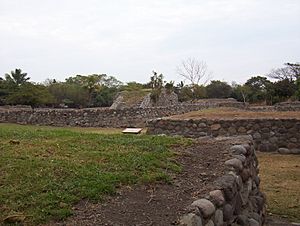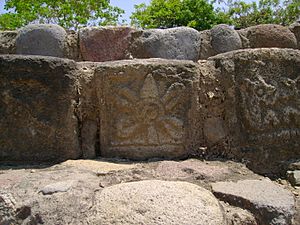El Chanal facts for kids
Quick facts for kids Archaeological Site in Colima |
||
| View of El Chanal archaeological site | ||
| Name: | El Chanal Archaeological Site | |
| Type | Archaeology | |
| Location | Colima City, Colima, Mexico | |
| Region | Mesoamerica | |
| Coordinates | 19°17′34″N 103°42′20″W / 19.29278°N 103.70556°W | |
| Culture | Unknown | |
| Chronology | 1100 - 1400 CE maximum splendor | |
| Period | Mesoamerican Postclassical | |
| INAH Web Page | El Chanal archaeological site | |
El Chanal is an amazing ancient site located about 4 kilometers (2.5 miles) north of Colima City in Mexico. It's huge, covering more than 50 hectares (about 123 acres)! This makes it likely the biggest ancient city in the Colima state. It was built along both sides of the "Río Verde" (Green River), also known as the Colima River. The local people of El Chanal town help take care of this important historical place.
People might have lived here as early as 1300 BC, but the city was at its busiest and most impressive between 1100 and 1400 CE (which means Common Era, or AD). Archaeologists have found items that show a connection to the Nahuatl culture, including statues of gods like Tláloc (the rain god) and Ehécatl (the wind god).
The buildings at El Chanal are special. They include temples with two parts, palaces with open doorways, and special areas for ceremonies. There are also Mesoamerican ballgame courts, which were very important in ancient times. Archaeologists have found many ceramic items, like special bowls called "braziers" and "sahumerios." These were used to burn copal resin, a type of incense, during religious ceremonies. Some colorful images found here show features of gods, carved into stone reliefs. These carvings have made the site quite famous.
There's still a lot we don't know about the daily life and important events in this great city. Scientists are still working to explore and understand more about El Chanal.
Contents
What Does "El Chanal" Mean?
The name "El Chanal" is linked to old stories about magical beings called "chanos." These beings were believed to live in water streams. Since many images of Tláloc, the rain god, have been found here, it's thought that El Chanal might have been a place for worshipping Tláloc.
One idea is that "El Chanal" means "Place inhabited by water custodians." In another part of Mexico, in the state of Chiapas, there's a town also called Chanal. There, the name means "wise man that teaches."
Who Lived Here?
We don't know for sure which ancient group lived at El Chanal. The pottery found here is different from other pottery usually seen in the Colima region.
It's believed that the people of El Chanal were skilled artisans. They knew how to work with metals. The discovery of metal objects, special pottery called "plumbate vessels," obsidian tools, and clay statues of figures like "Xantiles" and Xipe Totec suggests that the people of El Chanal might have been connected to the ancient city of Tula.
Sadly, many ancient pottery pieces from Colima were stolen and sold illegally. Some of these valuable pieces are now in museums far away.
Exploring the Ancient City
El Chanal has many important areas, including ceremonial spaces, open plazas, central altars, and ballgame courts. In 1945, an archaeologist named Vladimiro Rosado Ojeda explored the site. He found a pyramid with steps that had carvings on them. These carvings showed images of gods like Tláloc and Ehécatl. Some of the main structures at the site are the Ossuary, the Pyramid, and the Great Platform.
The builders of El Chanal cleverly used the natural slope of the Colima valley. They arranged the city to follow the land's shape. The pyramid structures were built using rounded stones from nearby rivers. Some of these stones have ancient carvings, called petroglyphs, showing animals, plants, and possibly gods.
El Chanal has six main plazas, or important ceremonial centers:
Altars Plaza
This plaza has two altars. One is rectangular and quite worn down. The other is round, and several ancient burials were found there.
Ballgame Court
This court is located south of the "Plaza del Tiempo" (Time Plaza). It measures about 38 by 13.5 meters (125 by 44 feet). The presence of a Mesoamerican ballgame court shows how important religion was at El Chanal. The game was more than just a sport; it was believed to represent the battles between gods that allowed day and night to exist. The god of the game was Xolotl, who was thought to travel with the sun through the underworld. The game was played by men and was very important for the future of their world.
Day and Night Plaza
This large open space is about 60 by 80 meters (197 by 262 feet). It is bordered by a wall to the south and structures to the east and west. The strong religious beliefs of the people of El Chanal are clear in these grand ceremonial spaces. Temples were seen as the homes of gods on Earth, and plazas were where people gathered for worship. Some temples were open to everyone, while others were only for religious and civil leaders. It's thought that people visited this plaza to burn incense, like copal, and offer simple tributes to the gods.
Time Plaza
The "Time Plaza" holds some of the most impressive buildings at the site, including structures 1 and 3.
Structure 2
This building has two levels on its west side and three levels on its east side.
Water Plaza
The "Water Plaza" is made up of several low platforms with inner courtyards, corridors, and open spaces.
High Patio
This area is believed to have been where people lived.
Altar Plaza
The round "Altar Plaza" offers a great view of the Altars and Time plazas.
How to Visit El Chanal
The El Chanal archaeological site is in the modern town of El Chanal. You can get there by taking a dirt road about 4 kilometers (2.5 miles) north of Colima City. The site is open Tuesday through Sunday from 9:00 AM to 5:00 PM.
Images for kids
See also
 In Spanish: El Chanal para niños
In Spanish: El Chanal para niños







